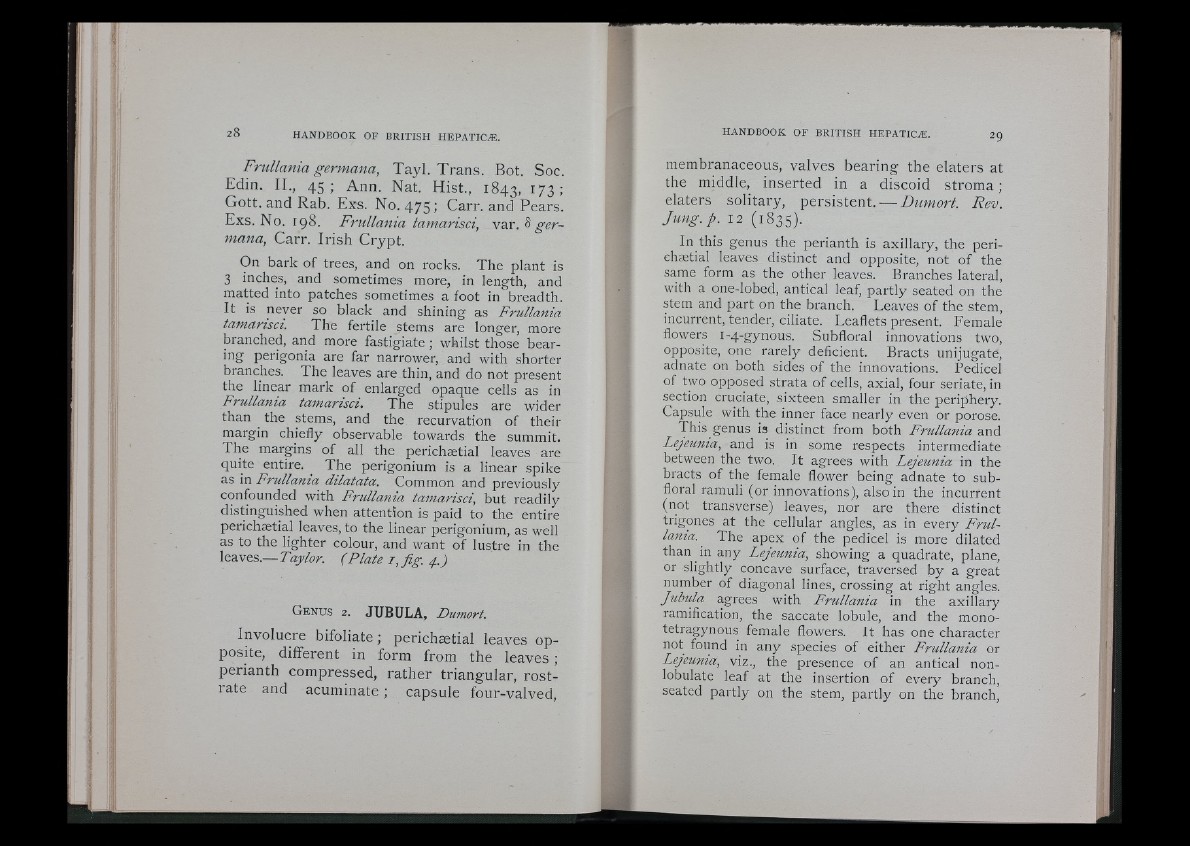
i
Frullania germana, T a y l . Trans . Bot. Soc.
Edin. II., 4 5 ; Ann. Nat. Hist., 1843, H 3 ;
Got t . and Rab. Exs. No. 4 7 5 ; Carr, and Pears.
Exs. No. 198. Frullania tamarisci, var. 8 g^r-
mana, Carr. Irish Crypt .
On bark of trees, and on rocks. The plant is
3 inches, and sometimes more, in length, and
matted into patches sometimes a foot in breadth.
It is never so black and shining as Frullania
tamarisci. The fertile stems are longer, more
branched, and more fastigiate; whilst those bearing
perigonia are far narrower, and with shorter
branches. The leaves are thin, and do not present
the linear mark of enlarged opaque ceils as in
Frullania tamarisci. The stipules are wider
than ^ the stems, and the recurvation of their
margin chiefly observable towards the summit.
The margins of all the perichsetial leaves are
quite entire. ^ The perigonium is a linear spike
as in Frullania dilatata. Common and previously
confounded with Frtdlania tamarisci, but readily
distinguished when attention is paid to the entire
perichsetial leaves, to the linear perigonium, as well
as to the lighter colour, and want of lustre in the
leaves.— Taylor. (Plate i,f ig . 4..)
Gen u s 2. JUBULA, Dumort.
Involucre bifoliate; perichaetial leaves opposite,
different in form from the leaves ;
perianth compressed, rather triangular, ro s t rate
and acuminate ; capsule four-valved.
membranaceous, v a lve s bearing the elaters at
the middle, inserted in a discoid stroma ;
elaters solitary, persistent . — Dumort. Rev.
Jung. p. 12 (1835).
In this genus the perianth is axillary, the peri-
ehætial leaves distinct and opposite, not of the
same form as the other leaves. Branches lateral,
with a one-lobed, antical leaf, partly seated on the
stem and part on the branch. Leaves of the stem,
incurrent, tender, ciliate. Leaflets present. Female
flowers 1-4-gynous. Subfloral innovations two,
opposite, one rarely deficient. Bracts unijugate,
adnate on both sides of the innovations. Pedicel
of two opposed strata of cells, axial, four seriate, in
section cruciate, sixteen smaller in the periphery.
Capsule with the inner face nearly even or porose.
Ihis genus is distinct from both Frullania 3.nà
Lejeunia, and is in some respects intermediate
between the two. It agrees with Lejeunia in the
bracts of the female flower being adnate to subfloral
ramuli (or innovations), also in the incurrent
(not transverse) leaves, nor are there distinct
trigones at the cellular angles, as in every Frul-
lania. The apex of the pedicel is more dilated
than ^ in any Lejeunia, showing a quadrate, plane,
or slightly concave surface, traversed by a great
number of diagonal lines, crossing at right angles.
Jubula agrees with Frullania in the axillary
ramification, the saccate lobule, and the mono-
tetragynous female flowers. It has one character
not found in any species of either Frullania or
Lejeunia, viz., the presence of an antical non-
lobulate leaf at the insertion of every branch,
seated partly on the stem, partly on the branch.